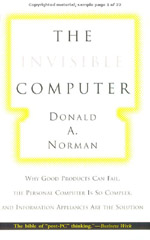 (Review reprinted with permission from The Wilson Quarterly, written by Edward Tenner)
(Review reprinted with permission from The Wilson Quarterly, written by Edward Tenner)
“When you come to a fork in the road, take it,” Yogi Berra is said to have counseled. Two decades after its birth, the personal computer industry has reached such a juncture. Microsoft’s hegemony has enriched many on Bill Gates’s version of The Road Ahead, while leaving critics (including antitrust lawyers) yearning for a diverging path. Gates has proposed an international supernetwork of machines from many manufacturers, delivering all forms of information, entertainment, and advertising, and controlled by different versions of a Microsoft Windows interface. The flaws are apparent: voluminous code, ubiquitous bugs, expensive support, fixes that introduce new problems, shifting interface standards.
While The Invisible Computer has few pages on Microsoft as such, author Donald Norman might be called the Anti-Gates. Norman, formerly a professor at the University of California, San Diego, and at different times an executive at Apple and Hewlett-Packard, is a cognitive psychologist challenging the conventions of colleagues from electrical engineering and computer science. His previous books have examined how people actually use things of all kinds, and how designers can reduce users’ frustration.
Instead of Gates’s master device, the personal computer, controlled by a standardized interface and doing many tasks simultaneously, Norman’s ideal is an array of “information appliances,” stand-alone products optimized for specific tasks. Most of our everyday technology is already dedicated, from radio and television receivers to toasters and microwave ovens. And we already have more special-purpose computers than we realize, from pocket calculators, organizers, and even translators to microprocessor-controlled video cameras. These rarely require bulky manuals or training courses, and we can carry them easily. Why, the author asks, can’t the rest of our information devices follow this model?
By abandoning what Norman considers the impossible goal of making complex tasks easy through a universal, intuitive interface, designers can produce special-purpose equipment that can be far easier to use. (Even today, standard spreadsheet software can generate no output as handy as the paper-tape record from a cheap pocket calculator, a device whose use requires almost no training.) In an appendix, Norman lists some new possibilities for information appliances, including a home medical adviser, a weather and traffic display, an electronic garden device that both monitors conditions and instructs owners, a home financial center, and even body implants.
Other researchers, notably those in the MIT Media Lab, have been developing some of these ideas. What makes Norman’s approach unusual is his vision of replacing rather than augmenting computing as we know it. Two concepts are essential. One is “human-centered development,” based not on asking people what they want but on observing their behavior. The other is development of a data exchange standard for information appliances so that producers can work together, bypassing the heretofore-sovereign central processing unit of the PC—and thus the operating system as we know it.
Norman recognizes the obstacles. He acknowledges that many human tasks are inherently difficult; even some apparently effortless ones take years of childhood and youth to master. He also understands that revolutionary, “disruptive” technologies are less appealing to managers than incremental improvements to existing technologies. Most seriously, he sees the necessity for a single data exchange standard. The endless wrangling over digital television and video disks, clouds the outlook, sadly, for future harmony involving even more divergent interests.
Readers need not agree with all of the author’s prescriptions to value his knowledge, insight, and humor. Historical vignettes—operating instructions for early radios, the rise and decline of the number of aircraft instruments—are delightful in their own right. Norman shows there is at least one road not yet taken.
Appetizer
Thomas Edison was a great inventor but a poor businessman. Consider the phonograph. Edison invented it, he had better technology than his competitors, and he did a sensible, logical analysis of the business. Nonetheless, he built a technology-centered phonograph that failed to take into account his customer’s needs. In the end, his several companies proved irrelevant and bankrupt.
—from The Invisible Computer